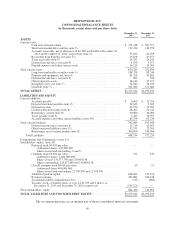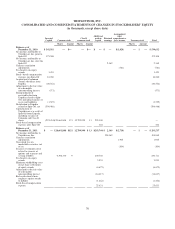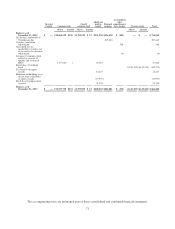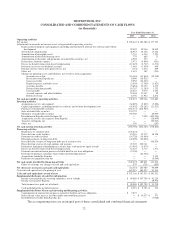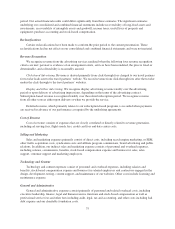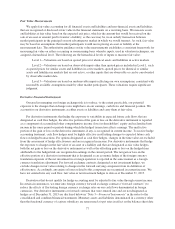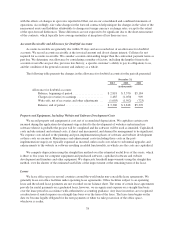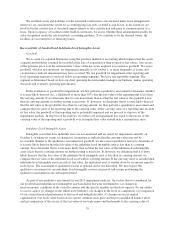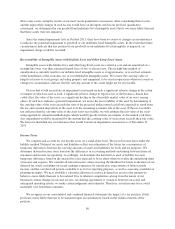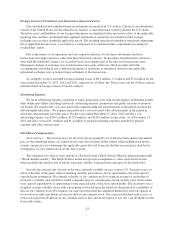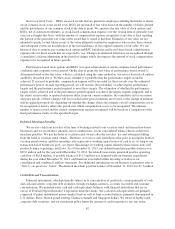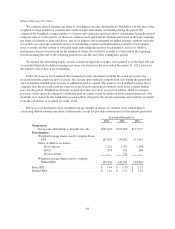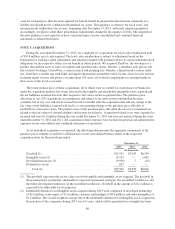TripAdvisor 2013 Annual Report Download - page 89
Download and view the complete annual report
Please find page 89 of the 2013 TripAdvisor annual report below. You can navigate through the pages in the report by either clicking on the pages listed below, or by using the keyword search tool below to find specific information within the annual report.We establish assets and liabilities for the estimated construction costs incurred under lease arrangements
where we are considered the owner for accounting purposes only, or build-to-suit leases, to the extent we are
involved in the construction of structural improvements or take construction risk prior to commencement of a
lease. Upon occupancy of facilities under build-to-suit leases, we assess whether these arrangements qualify for
sales recognition under the sale-leaseback accounting guidance. If we continue to be the deemed owner, the
facilities are accounted for as financing leases.
Recoverability of Goodwill and Indefinite-Lived Intangible Assets
Goodwill
We account for acquired businesses using the purchase method of accounting which requires that the assets
acquired and liabilities assumed be recorded at the date of acquisition at their respective fair values. Any excess
of the purchase price over the estimated fair values of the net assets acquired is recorded as goodwill. We assess
goodwill, which is not amortized, for impairment annually as of October 1, or more frequently, if events and
circumstances indicate impairment may have occurred. We test goodwill for impairment at the reporting unit
level (operating segment or one level below an operating segment). We have one reportable segment. The
segment is determined based on how our chief operating decision maker manages our business, makes operating
decisions and evaluates operating performance.
In the evaluation of goodwill for impairment, we first perform a qualitative assessment to determine whether
it is more likely than not (i.e., a likelihood of more than 50%) that the fair value of the reporting unit is less than
the carrying amount. If we determine that it is not more likely than not that the fair value of the goodwill is less
than its carrying amount, no further testing is necessary. If, however, we determine that it is more likely than not
that the fair value of the goodwill is less than its carrying amount, we then perform a quantitative assessment and
compare the fair value of the reporting unit to the carrying value. If the carrying value of a reporting unit exceeds
its fair value, the goodwill of that reporting unit is potentially impaired and we proceed to step two of the
impairment analysis. In step two of the analysis, we will record an impairment loss equal to the excess of the
carrying value of the reporting unit’s goodwill over its implied fair value should such a circumstance arise.
Indefinite-Lived Intangible Assets
Intangible assets that have indefinite lives are not amortized and are tested for impairment annually on
October 1, or whenever events or changes in circumstances indicate that the carrying value may not be
recoverable. Similar to the qualitative assessment for goodwill, we may assess qualitative factors to determine if
it is more likely than not that the fair value of the indefinite-lived intangible asset is less than its carrying
amount. If we determine that it is not more likely than not that the fair value of the indefinite-lived intangible
asset is less than its carrying amount, no further testing is necessary. If, however, we determine that it is more
likely than not that the fair value of the indefinite-lived intangible asset is less than its carrying amount, we
compare the fair value of the indefinite-lived asset with its carrying amount. If the carrying value of an individual
indefinite-lived intangible asset exceeds its fair value, the individual asset is written down by an amount equal to
such excess. The assessment of qualitative factors is optional and at our discretion. We may bypass the
qualitative assessment for any indefinite-lived intangible asset in any period and resume performing the
qualitative assessment in any subsequent period.
As part of our qualitative assessment for our 2013 impairment analysis , the factors that we considered for
our goodwill and indefinite-lived intangible assets included, but were not limited to: (a) changes in
macroeconomic conditions in the overall economy and the specific markets in which we operate, (b) our ability
to access capital, (c) changes in the online travel industry, (d) changes in the level of competition, (e) comparison
of our current financial performance to historical and budgeted results, (f) changes in excess market
capitalization over book value based on our current common stock price and latest consolidated balance sheet,
and (g) comparison of the excess of the fair value of our trade names and trademarks to the carrying value of
79


